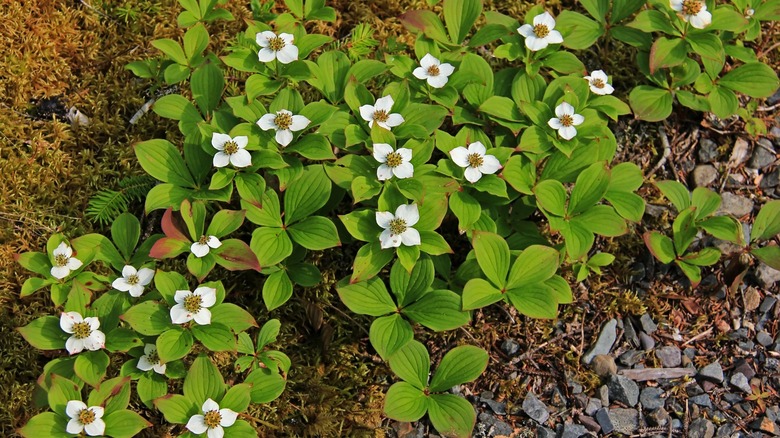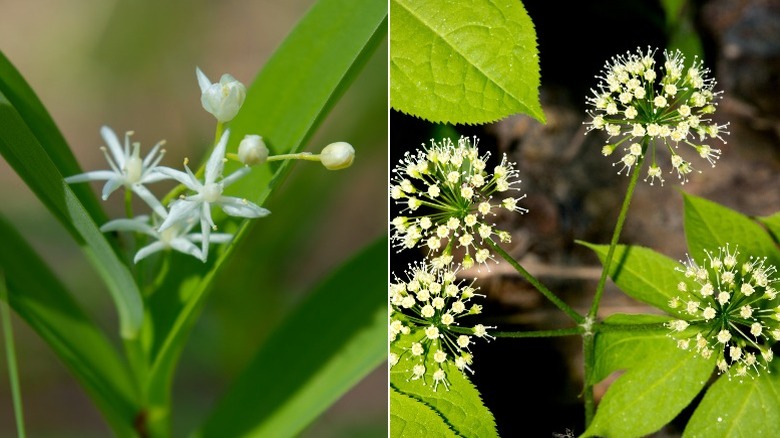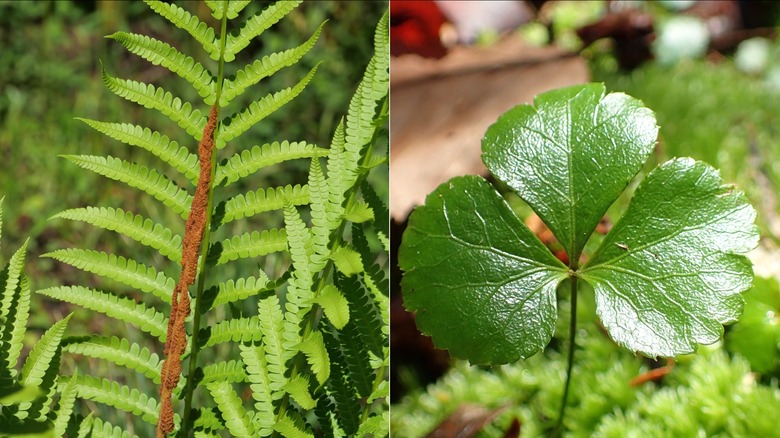The Perfect Plants To Grow Near Bunchberry Ground Cover
Bunchberry (Cornus canadensis), also known as bunchberry dogwood, is a perennial ground cover native to the U.S. This rhizomatic plant forms a type of jade green carpet over the ground, studded all over with pretty white flowers. In the summer, edible red berries also dot this low-growing dogwood. For gardeners looking for a deer-resistant ground cover perfect for a shade garden, bunchberry can be the ideal solution.
It thrives in moist gardens and acts as the perfect plant for a wild woodland outdoor space in USDA Hardiness zones 2 to 6. Along with moist soil, the bunchberry plant loves acidic conditions. Gardeners who grow it in cool, acidic areas in their yard have great success. Often planted in the shade of pine and hemlock trees, which helps foster the best acidic pH, good companion plants for the bunchberry share many of its environmental requirements. For the best plants to grow near bunchberry, consider False Solomon's seal (Maianthemum racemosum), wild sarsaparilla (Aralia nudicaulis), cinnamon fern (Osmunda cinnamonmeum), and three-leaf goldthread (Coptis trifolia).
Pair with attractive wildflowers that love moist, acidic soil
To contrast the low-growing nature of bunchberry, consider False Solomon's seal, a perennial that grows about 2 feet tall and 2 feet wide. This plant, native to woodland areas across North America throughout USDA Hardiness zones 3 to 9, enjoys moist soil and partial shade. Although Native Americans used parts of the plant for medicine, its value also lies in the little white flowers that grow in large clusters from spring to early summer. Plant it for a little variety alongside your low-growing bunchberry.
Another showy wildflower to grow near bunchberry is wild sarsaparilla. Also known as rabbit foot and wild licorice, its greenish-white flowers grow in spherical clusters of short stalks. Like bunchberry, this perennial wildflower likes moist, rich soil and tolerates shade well. It also prefers acidic soil but will easily tolerate more neutral soil. Grown near bunchberry, wild sarsaparilla attracts various pollinators, birds, and animals to your yard, including bees, White-throated Sparrow, and Eastern chipmunks. This wildflower is one of the best plants for a pollinator garden, together with False Solomon's seal and bunchberry.
Design the ideal woodland native garden
Because it thrives in moist, cool environments, bunchberry is an easy companion to other woodland natives. If you live in a cool climate, a woodland native garden may be the best option, and growing bunchberry, as well as cinnamon fern, can be simple. The cinnamon fern, a member of the royal fern family, gets its name because its fertile fronds (fiddleheads) gradually change from green to brown. The resulting look of this fern, which can reach 6 feet tall, has a vase-like shape that will add height to a woodland garden. Like bunchberry, cinnamon fern thrives in moist, acidic soil with sun, partial shade, or shade. Hummingbird lovers will want to add cinnamon fern to their garden, as the little birds use its fibers for their nests.
If you are looking for other woodland natives that grow well in acidic conditions, look no further than the three-leaf goldthread. This unique native, also known as canker root, is a perennial that grows showy white flowers with a hint of purple. Its name comes from the three evergreen leaves that grow below the flowers and the yellow underground stem that Native Americans would use to treat mouth sores (cankers). As an accompaniment to bunchberry, three-leaf goldthread can be intermixed to serve as a different kind of groundcover, growing only 3 to 6 inches tall.


